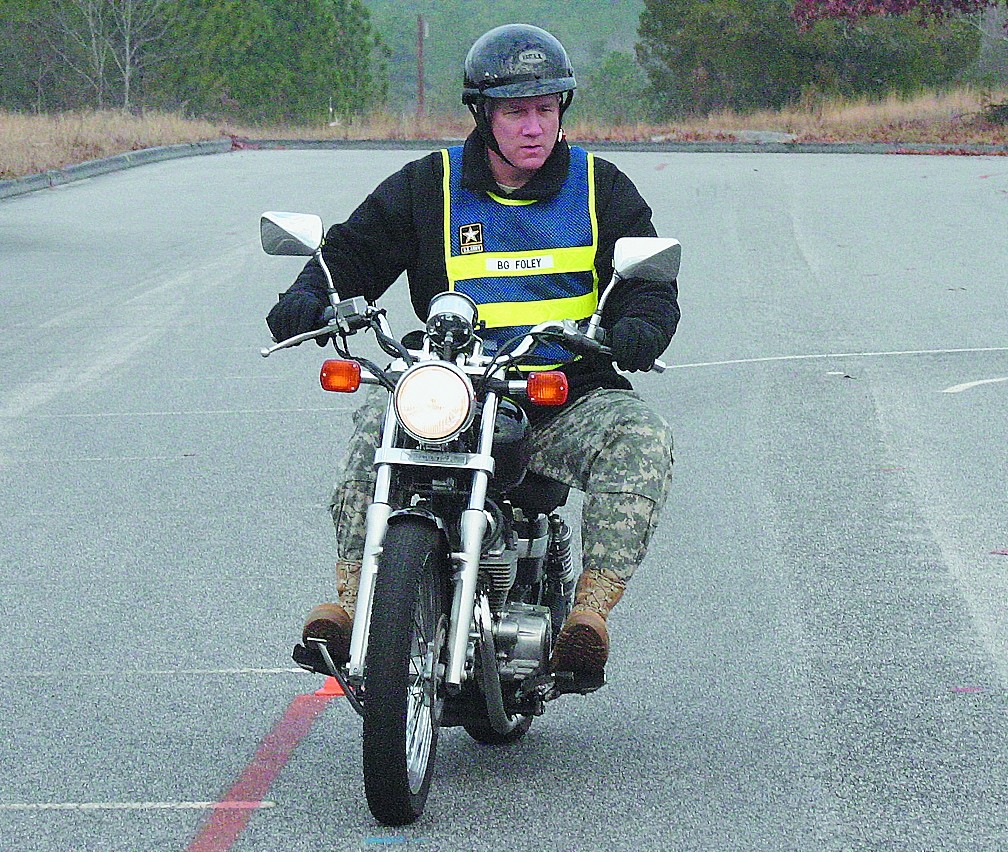FORT GORDON, Ga. (Army News Service, Mar. 10, 2008) -- Brig. Gen. Jeffrey Foley, U.S. Army Signal Center and Fort Gordon commanding general and Command Sgt. Maj. Thomas Clark, U.S. Army Signal Center and Fort Gordon command sergeant major, attended the Basic Rider Course recently.
"I took this course because right now, motorcycle accidents are the leading, non-combat related cause of death and injury to our service members. Motorcycle safety is so important, that I wanted to experience first-hand the level of training that our service members receive in the Basic Rider Course here at Fort Gordon," said Foley.
With spring just two weeks away many motorcycle enthusiasts are tuning up their bikes and heading for the open roads.
While motorcycle maintenance is essential, it is equally important to receive initial training for first-time riders, and refresher training for experienced riders in defensive as well as offensive driving techniques.
As a result of rising motorcycle fatalities the Department of the Army now requires motorcycle training for all active duty Soldiers, Reservists, National Guard members, contractors, and Department of Defense employees.
In accordance with Army Regulation 385-10, prior to operating a motorcycle, Army personnel must successfully complete an Army approved hands-on motorcycle rider course. Anyone registering a motorcycle on an Army installation must show proof of completing a Motorcycle Safety Foundation course, according to Russell Blandin, Fort Gordon motorcycle safety program manager.
"The Basic Rider Course and Experienced Rider Course are offered free of charge at Fort Gordon," said Blandin.
"Both courses use the Motorcycle Safety Foundation approved curriculum," said Byron Sylvester, a Cape Fox Inc. contractor, working in the Fort Gordon Safety Office.
"Successful completion of the BRC and/or ERC is mandatory for all Soldiers operating motorcycles on or off duty, regardless of whether the motorcycle is registered on post," Sylvester said.
The Army's standard motorcycle rider's course is now a MSF-based Basic Rider Course.
The BRC is a 15-hour course offered on a weekly basis at the Directorate of Public Works and Logistics/Safety Training Center, Building 11307, located at Lane Avenue and 12th Street on post. The actual riding phase of the course is conducted at the motorcycle riding range adjacent to the Gordon Club. The class is kept small with a six to one student/instructor ratio. Students do not need to own a bike; motorcycles are now available for use during the riding phase of the class.
The ERC is a six-hour class offered on a quarterly basis to all active duty military, Reservists, National Guard members, Fort Gordon civilians, contractors, military dependents and retirees, according to Blandin. The ERC is offered in addition to the BRC, but not in lieu of the BRC. Army personnel who have documentation proving completion of an ERC prior to Sept. 30, 2007 will be in compliance with the Army standard for motorcycle training and will not be required to attend the BRC to register their motorcycle on an Army installation.
In addition to the Commanding General and Command Sergeant Major, the following individuals attended the Basic Riders Course: Warrant Officer Troy Tarazon, a student at Company B, 442nd Signal Battalion; Spc. Sammy Vereen, lab technician assigned to the U.S. Army Dental Lab; Air Force Capt.Vondray Sanford, 31st Intelligence Squadron; and Capt. Michael Thompson, a dental resident in the root canal specialty [endodontic] program at the Dwight D. Eisenhower Army Medical Center.
In the classroom phase of the Basic Rider Course students are introduced to the types of motorcycles, risk management, motorcycle controls, and the correct personal protective gear to wear while riding a motorcycle. The pre-ride inspection using the T-CLOCS is discussed. Riders learn to examine the bike's tires and wheels, controls, lights and electrics, oil and other fluids, the chassis, and both the side and center stands to assure they are in good working condition before venturing out on the road.
Both lecture and video formats are used to train correct techniques for passing, stopping, turning, changing lanes, and moving through traffic. Sylvester discusses braking in a curve, dealing with obstacles in the road, night and group riding, and how to recover from a front and rear-tire skid.
Students use special eye goggles to experience how the body, particularly one's reaction time and equilibrium, are impaired by alcohol use.
Prior to going out to the motorcycle riding range, Sylvester demonstrates the RiderCoach signals he will use during the riding exercises. At the range, Sylvester mounts a bike to demonstrate each exercise. Throughout the riding phase of the course, Sylvester emphasizes safety. "You always start out in first gear," he reminds the students. "Remember 70 percent of your braking is accomplished with the front brakes."
"All riders must successfully complete 17 riding exercises in the BRC and a riding skill test which consists of four evaluations; and pass with at least 80 percent on the written test before an MSF card is issued," explained Sylvester. "All the students, including Foley and Clark, earned their MSF cards."
"After completing the course I do feel more confidence riding my bike," said Tarazon.
"I have been riding for two years, but I realize there is more to learn. Sylvester didn't just teach us how to ride, but he shared a lot of techniques on how to control your bike in various situations. It was a good confidence building course, he said."


Social Sharing